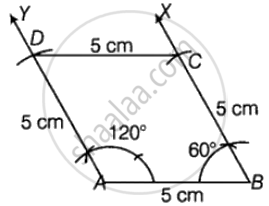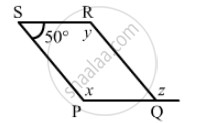Advertisements
Advertisements
Question
Construct a rhombus whose side is 5 cm and one angle is of 60°.
Solution

Suppose ∠B = 60°
∠A + ∠B = 180° ...[Sum of cointerior angles]
∠A + 60° = 180°
∠A = 120°
AB = BC = CD = DA = 5 cm
Steps of construction:
Step I: Draw AB = 5 cm.
Step II: Draw a ray AY that is ∠BAY = 120°.
Step III: Mark a point D that is AD = 5 cm.
Step IV: Draw a ray BX that is ∠ABX = 60°.
Step V: Mark a point C that is BC = 5 cm.
Step VI: Join C and D.
Hence, ABCD is the required rhombus.
APPEARS IN
RELATED QUESTIONS
The following figure is parallelogram. Find the degree values of the unknown x, y, z.

The sum of two opposite angles of a parallelogram is 130°. Find all the angles of the parallelogram.
The perimeter of a parallelogram is 150 cm. One of its sides is greater than the other by 25 cm. Find the length of the sides of the parallelogram.
Which of the following statement is true for a rhombus?
It is a quadrilateral.
Which of the following statement is true for a rhombus?
It is a square.
ABCD is a rhombus and its diagonals intersect at O.
(i) Is ∆BOC ≅ ∆DOC? State the congruence condition used?
(ii) Also state, if ∠BCO = ∠DCO.
Identify all the quadrilateral that have Four sides of equal length
All rhombuses are squares.
ABCD is a rhombus such that the perpendicular bisector of AB passes through D. Find the angles of the rhombus.
Hint: Join BD. Then ∆ABD is equilateral.
Construct a rhombus CLUE in which CL = 7.5 cm and LE = 6 cm.
